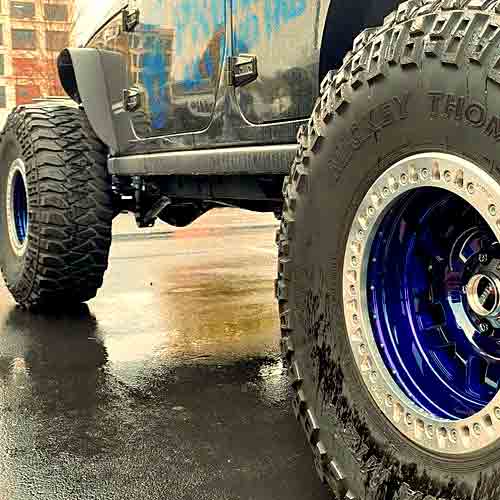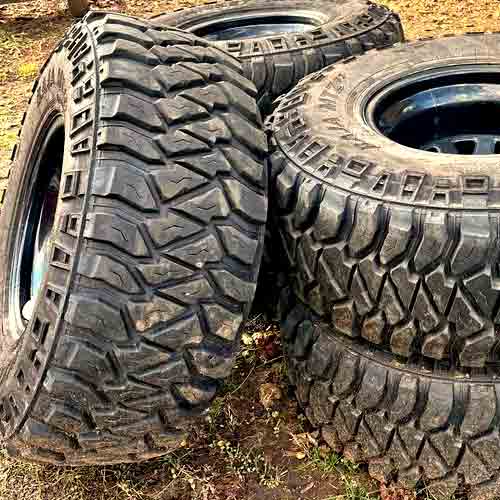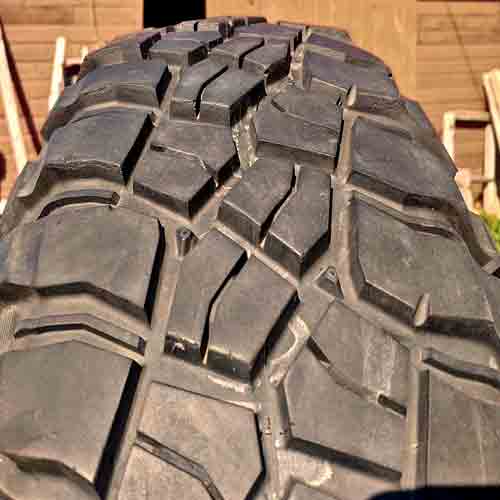Both the Mickey Thompson Baja MTZ and the BF Goodrich KM3 offer amazing traction on rough terrains and a smooth ride on pavements (when compared to other mud terrain tires). While they may not be all-purpose tires, if you know their strengths, they can be a great choice for you.

In my expert opinion as a tire engineer, the Mickey Thompson Baja MTZ brings about better winter traction, offers a relatively quieter ride, and provides better fuel economy as well as dry traction on highways. On the other side, the BF Goodrich KM3 is one of the best for sandy terrains, and the tire’s overall comfort (on highways), and wet traction is also much more appreciable.
Available Sizes
Starting with BF Goodrich KM3, the tire has following sizes specs.
- 14 to 22 inches rims (56 total sizes).
- Speed rating: Q only.
- Load rating: C to F.
- Weight range: 37 to 83 lbs.
- Tread depth: 18/32″ on all sizes.
On the other side, the Mickey Thompson Baja MTZ comes with following.
- Sizes: 15 to 20 rims.
- Speed ratings: Q only.
- Load range: C to F.
- Weight range: 47 to 94 lbs.
- Tread depth range: 19.5 to 22/32″.
Note: Both tires don’t have any treadwear warranty, nor they give out severe winter ratings, though M+S is available on all of their sizes.
Tread Structure
Let me start off with Mickey Thompson Baja MTZ, first.

Its tread features 2 packed up ribs in the middle, fomring sharp lugs of somewhat triangular geometries.
With biting edges and full depth sipes, these blocks offer epic off-road traction. Moreover, they also form both lateral and longitudinal grooves, allowing for faster mud and dirt evacuation on all terrain types.
Although these lugs are highly angled, they make a clear combination of lateral grooves, joining the shoulder voids prominently.
And with their packed up structure, they also ensure “directional” grip is also not compromised, by a lot, on pavements.
Though shoulder lugs only offer pure rugged terrain performance, featuring staggered outer edges, and sharp biting sidewall lugs, which give out extreme traction especially with lowered air pressure (PSI values).
Moving on, the BF Goodrich KM3 features a unique structure as well.

In the middle, there are two blocks seen, which are also laterally arranged (though they aren’t that slanted, in comparison).
I say laterally, because they are arranged in a way, that they seem part of shoulder lugs, only divided by longitudinal grooves.
These blocks have thick slits in them, which act as siping on snow and watery roads. Moreover, they also act as in-groove notches on rugged tracks.
The interconnected grooves, these lugs make have triangular shaped stone ejectors in them.
Moving towards shoulders, they lugs have a very minimalist design, as they aren’t seen with any tread features.
Though they are elongated, and have staggered outer margins, and their wider lateral voids, have bold stone ejectors in between.
Towards sidewalls, they also join together to form sidewall lugs, with deep biters in between.
Durability
Mud terrain tires must be designed to handle the rugged conditions of off-road driving, making durability a top priority.
To address this, these boys include cut-resistant rubber powerful deep tread blocks, yet most of their toughness comes from their internal structure.
And so in that manner, the Mickey Thompson Baja MTZ with its PowerPly XD 3-ply sidewall construction is taking the lead.
Though the tire has similar 2 steel belts and a single nylon reinforcement on top, like the BF Goodrich Km3.
Wet Traction
Optimal wet road performance is achieved by having both siping and flexibility in a tire’s tread design.
Sipes basically soak up water in their slits, and so they need flexibility to do that (otherwise, they won’t be able to create a proper suction).
That’s why considering both these aspects, it can be seen why both tires aren’t good enough.
Though still, out of them, you get a better directional grip on BFG KM3 because of it’s thicker siping slits in the middle.
Whereas, the overall cornering efficacy is seen better on Mickey Thompson Baja MTZ P3.
Dry Highways
When it comes to performing on roads, mud tires aren’t so famous, yet given their rugged performance, one can make compromise on the overall steering response and lateral/directional traction, the main components of dry performance.
Let me discuss these elements one by one below.
Steering Response
The steering response is a pretty important metric, as it tells you about the tire’s communication capabilities.
Having said that, out of both tires, the BF Goodrich KM3 is more sensitive to its steering inputs. Even though it comes with a relatively softer tread compound, it’s lugs still form a firmer contact with the ground.
The Mickey Thompson Baja MTZ on the other hand is not so great with it’s deeper tread voids (tread depth reaching up to 22/32″). This causes the lugs to be less supportive, resulting in greater flexing, and with it, limited steering response.
Directional Grip
Directional grip is mostly needed when you brake and accelerate (that’s why its measured with stopping distances).
And since rolling straight, most of the weight (on the tire), gets focused on the central area of the tread, it’s important to consider how much footprint a tire can make from there.
That’s why it makes sense why out of both, the Mickey Baja MTZ comes with superior results, with its much more packed up central area. Its lugs are not only densed up together, from there, but they also form an interlocking pattern with each other. This helps in a more even distribution of its weight as the tire rolls.
The BF Goodrich KM3 on the other side, comes with 2 feet shorter braking distances (on average), and it makes sense, considering its wider tread voids, and lateral orientation of lugs.
Dry Handling
Handling basically depends on the tire’s structural weight and how much contact it can make with its shoulder lugs.
And here both tires although offer similar footprints, the overall handling efficacy is seen better on BFG KM3, because of it’s superior steering response (which I already discussed above).
Fuel Usage
Fuel usage is directly proportional to the rolling resistance. And this metric is affected the most with the tire’s weight.
Having said that, even though both tires come with similar weighing sizes, the Mickey Baja MTZ is still able to produce lower rolling resistance values.
It’s lugs are basically more crowded up (especially from the middle), so its weight gets divided more evenly, and lugs bear relatively smaller pressure on them, as they rub against the road.
The BF Goodrich KM3 on the other side, not only puts more pressure on it’s lugs but it’s softer compound also causes greater lug bending, resulting in greater energy wastage.
This is also the reason, why it wear out faster too, in comparison. Though you don’t get any kind of warranty with both of these tires.
Ride Comfort
Ride quality of a tire is contingent on the tread noise it makes as well as its capability to settle down the bumps on/off road.
Here although the single nylon reinforcement (cap) plies on both tires, offer a lot of dampening to the vibrations, the overall performance is still seen better on BF Goodrich M/T.
So why is that?
Well, because this tire has a higher silica density in its rubber compound. This makes its tread much more malleable, and it becomes more able to soak up the road imperfections.
On the flip side, the Mickey Thompson Baja MTZ although lacks in providing as much impact comfort in comparison, it deals with noise in a better way, providing a relatively quieter ride.
Basically its tread is not as prone to groove resonance, it offers better variable pitch technology as well, so although you get a slightly humming and wobbling noise, it’s still shows up with smaller decibel values.
Also when it comes to M/T, my tests show that the Falken Wildpeak M/T (review) offers the top results.
Off Road Performance
Off-road I tested these tires out on following terrains.
Sandy Areas
The less digging tire does better on sand, that’s why both weight and tread structure are major factors here.
Having said that, it makes sense why the BF Goodrich KM3, with lighter structure, and having sidewall lugs pasted on larger surface area, offers better traction values, relatively.
Whereas, in comparison, the Baja MTZ stiffer sides isn’t that great.
Muddy Terrains
On mud you need self cleaning grooves, simply put, that’s why when mud clogs the tread, it’s contact with the muddy surface is without any kind of traction.
But being “mud-terrain” tires, it’s not an issue for both of our tires here. And upon testing, the BFG KM3 even comes out a little better, off the two.
The tire’s countless pathways all over the tread allow mud to more easily pass out the tread, in a given time, and its elongated shoulders and laterally oriented lug design account for superior mud scooping.
In comparison, although the Mickey Thompson Baja MTZ offer nice mud evacuation too, it slightly lacking in the paddling department, so it’s not able to create as much of a forward moving inertia, as its counterpart.
Rocks
For rocky terrains, although both tires offer decent durability (highly need factor), with better angled-gripping, the BF Goodrich KM3 still takes a larger piece of the pie.
Its full depth sipes of lateral and longitudinal orientations, basically provide grip in all directions (as they split open the blocks, and at the same time act as in-groove notches.
Moreover, it’s haphazardly placed central blocks help to that.
Snow Traction
On snow, there are a lot of variations, ice, road snow, deep snow, off-road, and so on.
And out of all these terrain types, the mud tires only are good with deeper tracks. As for on road snow, they show a lot of slippage, and for ice, they are straight up disappointing and dangerous.
That’s why these tires don’t come up with 3 peak mountain snowflake rating symbols (there’s none, in the category of mud-terrain tires).
Nonetheless, out of these two, the Mickey Thompson Baja MTZ provides better efficacy, with it’s slightly heavier structure, and snow trapping grooves, efficiently grabbing snow particles in, and making snow to snow contact with it, (which is better compared to rubber to snow contact).
This is because snowflakes have an intermingling structure, with their unique arms, so they easily stick with each other, generating greater friction.
On the other hand, the BF Goodrich KM3 is although not good enough, its still provides the scooping abilities just like its counterpart, and its thicker siping slits also provide ample snow contact as well.
To Sum Up
Let’s sum all of the above.
So comparing both tires, the tests showed that for winter performance, ride quietness, fuel economy and dry traction, Mickey MTZ is a better choice.
Whereas in case of sand traction, comfort performance (in terms of bumps absorption efficacy), and winter traction, the BF Goodrich KM3 supplies a relatively better experience.